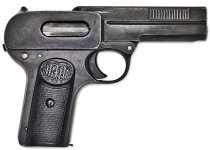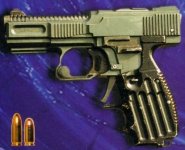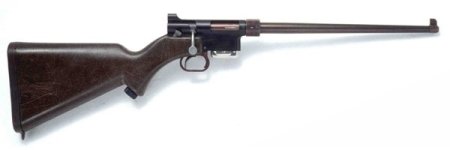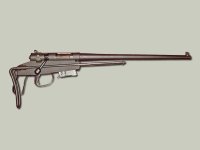Mike got that one answering most of the questions first.
I was surprised that the first sabot round was designed by the French which did field the gun. But since the armistice happened early in 40 luckly the designer was evacuated to England.
But the British were the first to field it in a tank. One article said that it was the only round that could reliably penetrate a Panther tank on the sloped front armor where as all other 74 would barely make a dent like the Sherman.
1000 British Sabot tank round from WW2
https://en.wikipedia.org/wiki/Armour-piercing_discarding_sabot
Armour-piercing discarding sabot
Armour-piercing discarding sabot (APDS) is a type of kinetic energy projectile fired from a rifled-barrel gun to attack armoured targets. APDS rounds are sabot rounds, firing a spin-stabilized armor penetrating sub-projectile, and were commonly used in large calibre tank guns, up until the early 1980s, but have now been superseded by armour-piercing, fin-stabilised, discarding sabot (APFSDS) projectiles used in smooth-bore guns, firing a fin-stabilized armor penetrating sub-projectile.[1] However, APDS rounds are still commonly used in small or medium calibre weapon systems. For a given calibre, this type of ammunition can effectively double the armour penetration of a gun, compared to those firing armour-piercing (AP), armour-piercing, capped (APC), or armour-piercing, capped, ballistic capped (APCBC) projectiles. The saboted light armour penetrator (SLAP) concept applies this technology to small arms calibres.
History and development[edit]
APDS was developed by engineers working for the French Edgar Brandt company, and was fielded in two calibers (75 mm/57 mm for the Mle1897/33 75 mm anti-tank cannon, 37 mm/25 mm for several 37 mm gun types) just before the French-German armistice of 1940.[2] The Edgar Brandt engineers, having been evacuated to the United Kingdom, joined ongoing APDS development efforts there, culminating in significant improvements to the concept and its realisation.The APDS projectile type was further developed in the United Kingdom between 1941–1944 by Permutter and Coppock, two designers with the Armaments Research Department. In mid-1944 the APDS projectile was first introduced into service for the UK's QF 6 pounder anti-tank gun and later in September 1944 for the QF 17 pounder anti-tank gun.[3]
The reason for the development of the APDS was the search for anti-tank projectiles with increased penetrating performance. It was known that high impact (terminal) velocity, or a larger diameter projectile would be required to improve penetration. A larger projectile would require a completely new weapon system and may have been too heavy to retrofit onto existing armoured fighting vehicles. Increasing the velocity of the current projectiles was also a problem due to the impact velocity limitations of steel armour-piercing (AP) projectiles, which would shatter at velocities above ~850 m/s when uncapped.
To allow increased impact velocity, a stronger penetrator material was required. The chosen new penetrator material was tungsten carbide (WC), due to its greater hardness and its ability to withstand the greater shock and pressure generated during a higher velocity impact. As the density of WC (≈15.7 g/cm³) is twice that of steel (≈7.86 g/cm³), such a shot was too heavy at full bore to be accelerated to a sufficient muzzle velocity. To overcome this, a lightweight full diameter carrier shell was developed to sheathe the inner high density core. The name given to this projectile type was the Armour-Piercing Composite Rigid (APCR). The APCR projectile was about half the weight of a standard AP shot, but of the same diameter. Due to the large surface area for the gases to impinge upon the lightweight APCR projectile, it experienced a higher average acceleration in the gun barrel, in turn imparting a higher muzzle velocity. Unfortunately the low sectional density of the APCR resulted in poor carrying power (high aerodynamic drag), losing velocity and penetration rapidly over distance.
To overcome these limitations the British devised a way for the outer sheath to be discarded after leaving the bore. The name given to the discarded outer sheath was the sabot (a French word for a wooden shoe). For APDS projectiles the sabot is also known as a pot, as the sabot resembles a flower pot in shape. The APDS has the advantages of the lightweight projectile with regards to bore acceleration and high muzzle velocity, but does not suffer from the high drag of the APCR in flight.
Sabot construction[edit]
The sabot of a large calibre APDS consists of a light high strength alloy full diameter pot and base unit, which is screwed together. The front part of the pot has 3-4 petals (sabots) which are covered with a centering band (often a nylon derivative). The rear half has a rubber obturator and driving band (again nylon) held in place by the screw-in base unit. The base unit, if a tracer element is attached to the sub-projectile, has a hole located at the centre. Before firing, the sub-projectile and sabot are locked together. Due to the high setback forces (g's), friction between the pot and sub-projectile allows spin to be transferred, thus stabilising the sub-projectile. Small/medium calibre APDS use a lightweight high strength alloy base pot and three or more plastic petals. To transfer the spin to the core in small/medium calibre weapons, the core tends to have a notch at its base. Under bore acceleration, which can be higher than 100,000 g, the uneven base is forced into the softer pot material, locking the sub-projectile to the pot and imparting spin. Not all small/medium calibre APDS rely on this technique, another method for spin coupling is by using the forward plastic petals. The petals are of a slightly larger diameter than the lands in the rifled bore. This forces the petals tightly against the core, increasing the friction between them and allowing the spin to be transferred.
Sub-projectile construction[edit]
The sub-projectile consists of a high density core with a penetrating cap, enclosed within a high strength sheath (steel) with a lightweight alloy (aluminum-magnesium alloy) ballistic cap. For modern small/medium calibre APDS projectiles, the core is not sheathed and the ballistic and penetrating caps are combined. A tracer element may be added to the APDS sub-projectile, for large calibre weapons this is part of the outer sheath, for small/medium calibre weapons it is contained within a hollow cavity in, or attached to, the base of the core. Most modern APDS projectiles used high strength shock resistant tungsten alloys. The main constituent is tungsten, alloyed or sintered with/to cobalt, copper, iron or nickel. Very few APDS use depleted uranium (DU) titanium alloy for the penetrator material, though the retired 20 mm MK149-2 Phalanx round did use DU.
Sabot discard[edit]
When a large calibre APDS is fired and while still within the bore, the setback forces shear the forward petals, partly unlocking the sub-projectile from the sabot, but still holding it rigidly within the pot. Gas pressure is used to delay the unlocking of the pins holding the rear part of the sub-projectile by gyroscopic forces. Once outside the barrel, the pins, centering band and forward petals are released or discarded by projectile spin, the aerodynamic drag removes the pot/base unit. As an APDS sub-projectile does not require driving bands and the core is supported at the base and ogive region, a far more aerodynamic projectile shape can be chosen. This, in combination with the sub-projectiles’ higher sectional density, gives the resulting sub-projectile vastly reduced aerodynamic drag in comparison to the APCR. Both the higher initial velocity and the reduced drag result in high velocity at impact. This also lowers flight time and improves accuracy. Accuracy can suffer if there are unwanted sabot/sub-projectile interactions during discard.







